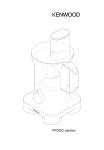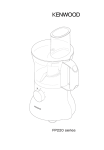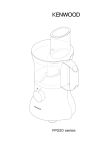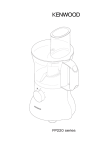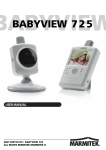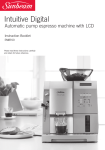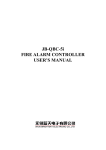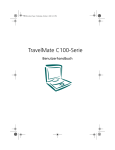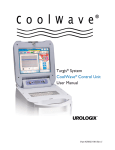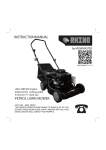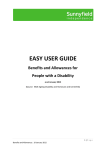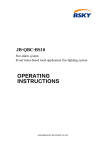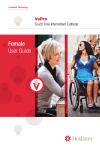Download Catheterisation – Male and SPC - Clinical Guideline, Competencies
Transcript
ACI Urology Network - Nursing Catheterisation – Male and SPC Clinical Guideline, Competencies, Troubleshooting and Patient Information Date: March 2013 Version: Updated March 2013 Release Status: Draft Release Date: Author: Urology Nursing Working Group Owner: Agency for Clinical Innovation Acknowledgements Denise Edgar (Continence Foundation), Kylie Wicks (BrightSky Australia), Claire Dobson (ACAT), Choon Chew & Colleen McDonald (WSLHD), Melissa O’Grady (SESLHD), Lindy Lawler, Jacqui Swindells, Mary Kelly (NSLHD) and Selvi Naidu (SWSLHD). The following pages provide a clinical guideline template to enable clinicians to develop their own resource material relevant to their hospital and Area Health Service. They have been compiled by clinicians for clinicians. If you wish to use this material please acknowledge those that have kindly provided their work to enable use by others. Revise all material with colleagues before using to ensure it is current and reflects best practice. Disclaimer: The information contained herein is provided in good faith as a public service. The accuracy of any statements made is not guaranteed and it is the responsibility of readers to make their own enquiries as to the accuracy, currency and appropriateness of any information or advice provided. Liability for any act or omission occurring in reliance on this document or for any loss, damage or injury occurring as a consequence of such act or omission is expressly disclaimed. AGENCY FOR CLINICAL INNOVATION Level 4, Sage Building 67 Albert Avenue Chatswood NSW 2067 Agency for Clinical Innovation PO Box 699 Chatswood NSW 2057 T +61 2 9464 4666 | F +61 2 9464 4728 E [email protected] | www.aci.health.nsw.gov.au Produced by: ACI Urology Network Nurses Working group Ph. +61 2 9464 4666 Email. [email protected] Further copies of this publication can be obtained from: Agency for Clinical Innovation website at: www.aci.health.nsw.gov.au Disclaimer: Content within this publication was accurate at the time of publication. This work is copyright. It may be reproduced in whole or part for study or training purposes subject to the inclusion of an acknowledgment of the source. It may not be reproduced for commercial usage or sale. Reproduction for purposes other than those indicated above requires written permission from the Agency for Clinical Innovation. © Agency for Clinical Innovation 2010 TABLE OF CONTENTS ASSESSING NURSING COMPETENCIES WHAT IS A COMPETENCY NURSING COMPETENCY: CHANGING CATHETERS RATIONALE CHANGING OF THE SUPRA PUBIC CATHETER (SPC) - STEP BY STEP GUIDE COMPETENCY ASSESSMENT FORMS CONTRACT AGREEMENT PAGE MALE URETHRAL CATHETERISATION AND CARE 4 4 4 4 7 13 18 19 DEFINITION 19 EXPECTED OUTCOME 19 CONSIDERATIONS 19 SPECIFIC SPINAL CORD CONSIDERATIONS 20 EQUIPMENT 20 PROCEDURE 21 COMPETENCY ASSESSMENT FORMS 24 THEORY 24 PRACTICAL 25 DISCHARGE PLANNING CHECKLIST FOR INDWELLING CATHETER IN SITU 31 Urethral or suprapubic catheter 31 Problem solving with catheters 32 CATHETER TROUBLESHOOTING GUIDE 34 TEST HOW MUCH YOU KNOW 35 Questionnaire 35 Answers 36 PATIENT EDUCATION LEAFLETS 39 CATHETER GUIDE FOR PATIENTS 39 ORDERING OF SUPPLIES 40 SUPPLY OF EQUIPMENT AND FUNDING BODIES 41 Continence Aids Payment Scheme (CAPS) 41 Enable NSW Aids and Equipment Program 41 BrightSky Australia offers 42 Independence Australia 42 Intouch Direct 42 Chemist 42 Supermarkets 42 Department of Veterans’ Affairs (DVA) 43 REFERENCES 44 Page 3/44 Assessing Nursing Competencies WHAT IS A COMPETENCY Although the words sound alike, competence and competency are not synonymous. Competence refers to a potential ability, a capability to function in a given situation. Competency is defined as a combination of attributes enabling performance of a range of professional tasks to the appropriate standards. Competency focuses on your actual performance in a situation. This means you need competence before you can expect to achieve competency. Competence enables you to be capable of fulfilling your job responsibilities. Competency however, means that you fulfill your job as expected. Competency is determined by comparing where you are now with established performance standards developed in the work environment according to your role and setting. Competency standards specify the level of achievement expected and the tasks and contexts of professional practice in which we may see the competency demonstrated. Competence does not mean expert. Various levels of competence exist and each of these has a minimum acceptable level or standard. Beginners are rarely expert however they can be competent. They perform a wide range of nursing activities methodically and well. The time to complete tasks may take longer however as skill level develops so too, will proficiency. They have to ask many questions however are aware of which questions to ask. Nursing Competency: Changing Catheters The aim of the competency is to ensure the student is able to demonstrate prior knowledge and can perform male and suprapubic catheterisations to a standard set by the Area Health Service. It is necessary that the student has theoretical knowledge (competent). This knowledge may be gained by attending a study day or undertaking a learning package (at the discretion of each Area Health Service). The student is required to undertake practical sessions with a supervisor in both male and suprapubic catheters (competency). The supervisor is responsible for identifying the number of supervised sessions for each student to be deemed competent. A supervisor must be a nurse continence advisor, a urology nurse or a person deemed capable of supervising male and suprapubic catheterisations by experience. The student is responsible for maintaining their skill level. In the event where a nurse has been unable to undertake a catheterisation for a length of time and feels they require supervision, it is their responsibility to contact the supervisor for additional supervision. Written records will be kept of each nurse that undertakes the competency procedure (at the discretion of the Area Health Service). RATIONALE Indications for catheterisation To relieve urinary retention To instil medications Page 4/44 To monitor accurate urinary output To preserve skin integrity To manage and maintain urinary system during surgical procedure Investigative procedures Competency assessment is required because: The ability to change a suprapubic or male catheter safely and effectively is an essential skill for Registered Nurses as it is performed routinely in numerous clinical settings. Change of a suprapubic or male catheter is an extension of the general Registered Nurse role. Competent assessment and education of the patient / client requiring a suprapubic or male catheter change is necessary to minimise and prevent complications. Assessment of nursing performance should occur against the relevant facility policy for change of a suprapubic or male catheter. Prerequisites may wish to be determined for the nurse to undertake prior to undertaking the change of suprapubic or male catheter assessment: Attend an Introduction to Continence Program. Read the facility specific policy and procedure guidelines for change of SPC/male Observe a Registered Nurse who has achieved competency in this procedure. Identify the OH&S principles that apply to the safe change of a SPC/male. Complete a worksheet prior to undertaking the assessment. Underpinning knowledge is required of the following: Facility policy. Standard precautions Principles of manual handling Preparation for assessment Schedule a time to attend a continence clinic or liaise with an accredited assessor in your facility. Discuss the assessment process with the patient in order to gain verbal consent. Community Health nursing staff may be able to have their assessments completed in the patient’s home subject to the patient’s consent and following negotiation with the appropriate staff members. Essential components to be assessed Professional attitude and rapport with the patient. Patient assessment and planning. Performance of the change of SPC/male procedure. Problem-solving skills and application of theoretical aspects. Relevant occupational health and safety principles applied to the procedure. Methods of assessment Direct observation of the Registered Nurses technique. Questioning techniques. Page 5/44 Demonstrated problem-solving skills in relation to suprapubic/male catheter management. Unsatisfactory Assessment In the event of an unsatisfactory assessment the following is a guide to appropriate action: The registered nurse is to receive feedback from the assessor about the observed deficits. The assessor determines with the registered nurse how the skill or knowledge deficit could be best improved. Further educational support might be required to prepare the registered nurse for the repeat assessment. This could take the form of further supervised practice or revision of reading resources, including policy review. This will need to be negotiated between both parties and documented. A repeat assessment is to be scheduled. If three consecutive attempts are unsuccessful, a further educational, development plan is to be implemented following discussion with the relevant parties. Relevant parties may include the registered nurse, nurse unit manager, nurse educator and clinical nurse consultant. The registered nurses and the relevant nurse unit manager are to be kept informed of progress and any additional education support that is being implemented. Reassessment Reassessment of change of suprapubic/male catheter technique is required every three years or as per local policy. Page 6/44 Changing of the Supra Pubic Catheter (SPC) - Step by Step Guide Pre Requirements An extended role for a registered nurse. The nurse must be deemed as competent to perform alone as per local Area Health Service policy. Expected Outcome Bladder is drained with patient and staff safety maintained Specific Spinal Cord Considerations If client is a spinal cord injured client above T6 understand autonomic dysreflexia and ensure treatment algorithm for autonomic dysreflexia in spinal cord injury is present If spinal client ascertain if client has used Viagra or Levitra in the last 24hrs or Cialis in the last 4 days as GTN spray, tablet or patches cannot be used Alerts Do not clamp the catheter in SCI above T6 Ascertain if client is on anticoagulants prior to procedure If the client has an artificial heart valve, discuss antibiotic cover with medical officer prior to change. Potential risk of creating a false passage associated with forced instrumentation Balloon inflated in urethra/tract resulting in trauma, haemorrhage, rupture or necrosis Autonomic dysreflexia handout to be given to all patients/ clients with a spinal cord injury at or above the 6th thoracic level and who have a urethral catheter in situ Autonomic Dysreflexia (AD) is a potentially life-threatening condition, which affects people with a spinal cord injury (SCI) at or above the thoracic level 6 (T6). This condition results from widespread reflex activity of the sympathetic nervous system below the level of injury, triggered by an ascending sensory (usually noxious) stimulus. AD can cause a sudden rise in blood pressure that can lead to stroke or even death. One of the common causes is a distended or severely spastic bladder, urinary tract infection, bladder or kidney stones, urological procedure or even inserting a catheter. Episodes of AD could occur during a catheter change. Be alert for sudden hypotension due to rapid draining of bladder or sudden resolution of AD. Initially drain 500mls and then 250mls every 15minutes until bladder is empty. (http://www.aci.health.nsw.gov.au/__data/assets/pdf_file/0019/155143/algorithm.pdf) Remember: this is a medical emergency and the patient is not to be left alone. Blood pressure should be monitored throughout treatment. Patients with a spinal cord injury at T6 and their carers should have a copy of the NSW Health ‘Autonomic Dysreflexia Medical Emergency Card’ which is available using the following link: http://www.aci.health.nsw.gov.au/__data/assets/pdf_file/0020/163442/Medical-EmergencyCard.pdf Page 7/44 Equipment Catheter pack. This includes - sterile lubricant - sterile water 10ml ampoule - normal saline ampoule 20 to 30mls - 2x 10ml syringes - 1pr of sterile gloves - fenestrated drape 1 sterile catheter appropriately sized and recommended for supra pubic use ( a female or male length catheter can be used) Additional sterile gloves will be required if using procedure B Catheter strap or disposal catheter fixation device Sterile drainage bag and or catheter valve Protective eye wear Disposable protective apron Disposable gloves Sterile intermittent catheter preferably pre lubricated. (If not pre lubricated then you will also require additional sterile lubricant) Specimen jar if required Split drainage sponge if required Blue disposable sheet Rubbish bag Local anaesthetic if required Sterile suture cutter if required (initial SPC may be sutured in) Procedures Procedure A or B can be used to change a SPC. A second pair of sterile gloves is required using procedure B. Once the catheter has been removed a new catheter must be inserted immediately this is particularly relevant for those that experience bladder or abdominal spasm. Page 8/44 Procedure A Single gloved procedure. The removal of the catheter occurs with the non-dominant hand (non sterile hand) the new catheter is immediately inserted with the dominant hand (sterile hand). The dominant hand and non dominant hand should not be interchanged. Explain procedure to client and ascertain the appliances you are using are correct e.g. catheter size and type, drainage bag type and size Ensure privacy Ensure patient is lying down for procedure Apply protective eye wear and protective apron Wash hands and apply non sterile gloves Expose supra pubic site, remove dressing if necessary Empty urine drainage bag Dispose of non sterile gloves and wash hands Open catheter pack using aseptic technique ensuring contents are spread across sterile dressing field. Open catheter onto sterile field using a non touch technique If required open sterile catheter valve onto sterile field using a non touch technique Open sterile disposable drainage bag leaving drainage bag cap in place Apply disposable gloves Remove 1x 10ml syringe from sterile field without touching sterile field.(place hand under plastic sterile field and raise the syringe off the field and place to the side Remove or undo catheter strapping Wash hands using an aseptic technique Apply sterile gloves Arrange equipment on sterile field, remove covering from catheter, open sterile water and normal saline into separate compartments of the catheter pack tray, apply lubricant to tip of sterile catheter and draw up recommended instillation volume as per catheter package. (Child SPC catheters generally have 3cc balloon)(Individual clinician choice if balloon of catheter is to be tested prior to inserting, if testing balloon use passive deflation) Soak sufficient gauze with normal saline to clean SPC site Page 9/44 Place fenestrated drape onto client immediately beneath the SPC site, leave sufficient room to clean the around the SPC site Clean around the SPC site with pre soaked gauze in a clockwise direction using new gauze for each wipe non dominant hand Look at the catheter insitu and visualize how much of the catheter is inserted through the SPC site Place the catheter tray or kidney dish onto the fenestrated drape With non dominate hand hold onto the catheter insitu With dominant hand pick up the sterile catheter Deflate balloon using 10ml syringe note the amount of water removed from the balloon and expect 1 to 2mls less than that put in the balloon With non dominant hand rotate the catheter insitu and remove Immediately with dominate hand insert new catheter to the depth and angle of previous catheter, generally about 10cm although this can vary dependant on the abdominal girth of the client, ensuring the outflow end of the catheter is in the catheter tray or kidney dish (Do not insert the catheter so far that it is in the urethra) If urine drains, continue to insert the catheter another 1-2cms to ensure the balloon is inflated within the bladder. Inflate the balloon in accordance with product recommendations. Gently pull back on the catheter until resistance is felt Throughout this procedure observe the client for signs of discomfort If urine is not draining wait for this to occur Flick the protective cap off the drainage bag and connect sterile drainage bag (apply leg drainage bag straps as per manufactures instructions) or connect catheter valve ensuring valve is in the off position Apply split drainage sponge to SPC site if required. If gauze is used do not cut it but rather wrap around the catheter (to protect possible migration of fibres) Apply catheter strap or disposable catheter fixation device Apply leg drainage bag straps as per manufacturer’s instructions Dispose of waste in accordance with infection control policy Assist client to dress and mobilize Document catheter type, amount of water used in balloon and any incidences e.g. autonomic dysreflexia, difficulty removing catheter, bleeding site etc Page 10/44 Procedure B This procedure maybe used for people who experience bladder spasm throughout the procedure. Double gloved procedure that uses the dominant hand to both remove and replace SPC maintaining asepsis. Explain procedure to client and ascertain the appliances you are using are correct e.g. catheter size and type, drainage bag type and size Ensure privacy Ensure patient is lying down for procedure Apply protective eye wear and protective apron Wash hands and apply non sterile gloves Open catheter pack using aseptic technique ensuring contents are spread across sterile dressing field. (If using basic dressing pack, add additional contents using non touch technique except for 1x 10ml syringe and sterile gloves that you place to the side) Open catheter onto sterile field using a non touch technique If required open sterile catheter valve onto sterile field using a non touch technique Open sterile disposable drainage bag leaving drainage bag cap in place Apply disposable gloves Remove 1x 10ml syringe from sterile field without touching sterile field (place hand under plastic sterile field and raise the syringe off the field and place to the side) Remove or undo catheter strapping Wash hands using an antibacterial agent for the recommended time Apply sterile gloves (2) Arrange equipment on sterile field, remove covering from catheter, open sterile water and normal saline into separate compartments of the catheter pack tray, apply lubricant to tip of sterile catheter and draw up 5 to 10mls of sterile water into 10ml syringe dependant on catheter requirements (Child SPC catheters generally have 3cc balloon). Soak sufficient gauze to clean SPC site Place fenestrated drape onto client immediately beneath the SPC site, leave sufficient room to clean the around the SPC site Clean around the SPC site with pre soaked gauze in a clockwise direction using new gauze for each wipe Page 11/44 Place the catheter tray or kidney dish on the fenestrated drape Place the non dominant hand around the SPC site ensuring that the catheter insitu is exposed between the thumb and index finger Apply gentle pressure to supra pubic area with the non dominate hand, at the same time place the dominant hand around the catheter close to where the catheter exits the body, rotate, remove and discard the catheter Remove the first pair of sterile gloves leaving on the second pair of sterile gloves Immediately with your dominate hand pick up the new catheter and insert new catheter to the depth and angle of previous catheter, generally about 10cm although this can vary dependant on the abdominal girth of the client, ensuring the outflow end of the catheter is in the catheter tray or kidney dish (Do not insert the catheter so far that it is in the urethra) Deflate balloon using 10ml syringe note the amount of water removed from the balloon and expect 1 to 2mls less than what was put in the balloon If urine is draining, continue to insert the catheter another 1-2 cms to ensure the balloon is inflated within the bladder. Blow up the balloon in accordance with product recommendations. Gently pull back on the catheter until resistance is felt. Throughout this procedure observe the client for signs of discomfort If urine is not draining wait until urine drains and then inflate the balloon in accordance with product recommendations. Gently pull back on the catheter until resistance is felt. Throughout this procedure observe the client for signs of discomfort Flick the protective cap off the drainage bag and connect sterile drainage bag to catheter (apply leg drainage bags straps as per manufacturers’ instructions) or connect catheter valve ensuring valve is in the off position Apply split drainage sponge to SPC site if required. If gauze is used do not cut it but rather wrap around the catheter. Apply catheter strap or disposable catheter fixation tape. Dispose of waste in accordance with infection control policy. Assist client to dress and mobilize. Document catheter type, amount of water used in balloon and any incidences e.g. autonomic dysreflexia, difficulty removing catheter, bleeding site etc. Page 12/44 COMPETENCY ASSESSMENT FORMS THEORY Competency: Changing a Supra pubic Catheter The student is required to show theoretical knowledge of supra-pubic catheterisations either verbally or in writing prior to undertaking the practical component. COMPONENTS OF SUPRAPUBIC CATHETERISATION TO BE DISCUSSED YES NO COMMENTS Describes the anatomy and physiology of the urethra, the bladder and abdominal cavity Understands the indications for indwelling catheterisation Discusses the procedure including the equipment required and the technique Discusses type of catheters available, duration of catheter, balloon size, closed drainage systems and can provide rational for choice Identifies complications that can occur during catheterization and discusses solutions Identifies complications that can occur during the removal of the catheter and discusses solutions Identifies care of and complications of the catheter in situ Discusses special considerations of catheterisation e.g. MS client, autonomic dysreflexia in the spinal injured client, sexuality, quality of life Discusses OHS considerations Discusses legal issues (verbal consent, education, documentation of procedure) Page 13/44 Practical Competency Assessment Forms Option 1: Changing Supra Pubic Catheter Assessment Form Name of Individual: Date of Assessment: Name of Assessor: Signature of Assessor: Ward/Location: Objective: Performance Criteria Professional Attitude and Patient Communication. Yes No Introduces self to patient. Explains that the procedure for the change of SPC is being observed and assessed. Gains verbal or inferred consent from the patient. Directs visitor / spouse to the waiting area if applicable. Addresses any patient concerns that may arise re the procedure. Performance Criteria Patient Assessment and Planning Explains the procedure to the patient. States indication/s for change of SPC. Follows the requirements for bladder preparation – as per local policy. Provides rationale for catheter selection. Identifies and plans for potential difficulties. Considers the need for pre-procedure medications. Performance Criteria Change of SPC Procedure Assembles and prepares equipment. Positions patient correctly and continually reassures the patient during the procedure. Deflates the balloon. Page 14/44 Performance Criteria Change of SPC Procedure cont. Yes No Dons goggles. Performs hand wash and dons sterile gloves. Drape the client. Cleans the area using the appropriate solution (as per local policy). Gauze is used for ‘no-touch’ technique. Removes catheter with non-dominant hand, and then inserts new catheter. If untoward resistance is felt on removal, place non-dominant hand on abdomen close to the stoma to support the site as the catheter is withdrawn. Describes why catheter should be gently pulled until resistance is felt Secure catheter to abdomen. Ensures urine flow is present prior to leaving the patient/client. Inflate the balloon with sterile water. Collects sterile urine specimen if required. Connects catheter to the appropriate drainage system. Secures catheter and ensures patient comfort. Apply dressing if SPC site oozing Provides appropriate patient education. Discards all equipment appropriately. Documents the procedure. Informs nurse in-charge of results Page 15/44 Performance Criteria Problem Solving Skills. RN outlines the reasons for and the management of: Yes No urine flow. Bladder spasm or bypassing. Reinflates then deflates balloon (ensure balloon in bladder) if difficulty removing catheter. Inability to insert the catheter. Possible solutions: Gets patient to cough, apply gentle pressure to abdomen and give a glass of water if SPC difficult to insert. Instil 2-3ml of lignocaine into SPC site if difficulties persist. Insert a smaller intermittent catheter and secure to abdomen if catheter cannot be inserted. Identifies to contact appropriate personnel as per local policy if SPC cannot be inserted. Stoma assessment: Performance Criteria OH&S Issues Identified and Applied. RN identifies the following aspects of OH&S whilst changing a suprapubic catheter: Procedure requires aseptic technique. Use of personal protective equipment (gloves / goggles). Back care and positioning of the patient, self and equipment trolley. Correct disposal of contaminated waste. Prevention of cross infection. Page 16/44 No Option 2: Changing Supra Pubic Catheter Assessment Form COMPONENTS OF SUPRAPUBIC CATHETERISATION PROCEDURE TO BE ASSESSED YES NO COMMENTS Ensures rapport with client and receives consent to undertake procedure. Invites questions prior to procedure Identifies and plans for any complications with catheter change by checking client records and asking the client. Identify actions that were taken and prepares. Follows OHS guidelines for safety and infection control Assembles correct type of catheter, balloon size, and drainage systems for the client Ensure client is in correct position Removes indwelling catheter as per protocol Takes appropriate action of complications Inserts new catheter as per protocol Takes appropriate action of complications Post insertion Leaves catheter in correct position and secured Connect to drainage system Ensures urine drainage Ensures client comfort Ensure client education Documents the procedure (verbal consent, , difficulties, catheter size and balloon size, education given to client) Disposes of equipment correctly Page 17/44 CONTRACT AGREEMENT PAGE Clinical supervisor please sign if appropriate knowledge DEMONSTRATED ________________________________________________________________ Clinical supervisor please sign if appropriate practice of catheterisation DEMONSTRATED __________________________________________________________________ Clinical supervisor please sign if appropriate knowledge NOT DEMONSTRATED at this stage __________________________________________________________________ Clinical supervisor please sign if appropriate practice is NOT DEMONSTRATED at this stage __________________________________________________________________ Comments by supervisor: __________________________________________________________________________ __________________________________________________________________________ __________________________________________________________________________ __________________________________________________________________________ __________________________________________________________________________ Comments by student (reflection of learning): __________________________________________________________________________ __________________________________________________________________________ __________________________________________________________________________ __________________________________________________________________________ __________________________________________________________________________ Clinical supervisor (print name): _______________________ Signature ___________________________________________ Date: _______________________________________________ Students name (print name) ___________________ Signature: ___________________________________________ Date: _____________________ Page 18/44 Male Urethral Catheterisation and Care DEFINITION A catheter is passed through the urethra into the bladder. EXPECTED OUTCOME The urinary bladder is drained with patient and staff safety maintained. CONSIDERATIONS Medical Officer must document the order for catheter insertion and removal of an indwelling catheter in health care records. Letter of authority has to be obtained from the Urology Medical Team for catheter change in the community for clients with prostate cancer who have non obstructive or have no obvious risk of having difficult replacement of their IDC. Staff must wear personal protective equipment (PPE). If urine output is less than 30mls consecutively for two hours notify Medical Officer. Long term urethral catheters to be changed every 4 -6 weeks or as specified by urology team. Collection of specimen for microscopic urinalysis and culture must be done within 48hours of insertion, if it is clinically indicated (offensive or cloudy urine and elevated temperature).Catheters are colonised after that period and if a specimen is required a new catheter should be inserted before the collection is made. Ensure patient has taken anticholinergic medication (if has been prescribed for bladder spasms) one hour before catheter change. Prior to catheter change it is recommended to have urine in bladder by clamping catheter below catheter Y junction for urine drainage to occur and to prevent adhesion to bladder wall. Irrigation of a blocked catheter to be only done with a 3-way catheter. If a 2 way catheter is blocked, remove catheter and insert a new catheter. When feasible, indwelling catheters are to be removed at 6am or midnight. In an acute setting, if patient requires opioid medication before catheter change, the patient has to be monitored before discharge as per medication guideline. Page 19/44 SPECIFIC SPINAL CORD CONSIDERATIONS If client is a spinal cord injured client above T6 understand autonomic dysreflexia and ensure treatment algorithm for autonomic dysreflexia in spinal cord injury is present If spinal client ascertain if client has used Viagra or Levitra in the last 24hrs or Cialis in the last 4 days as GTN spray, tablet or patches cannot be used Alerts Do not clamp the catheter in SCI above T6. Ascertain if client is on anticoagulants prior to procedure. If the client has an artificial heart valve, discuss antibiotic cover with medical officer prior to change. Potential risk of creating a false passage associated with forced instrumentation. Balloon inflated in urethra/tract resulting in trauma, haemorrhage, rupture or necrosis. Autonomic dysreflexia handout to be given to all patients/ clients with a spinal cord injury at or above the 6th thoracic level and who have a urethral catheter in situ. Autonomic Dysreflexia (AD) is a potentially life-threatening condition, which affects people with a spinal cord injury (SCI) at or above the thoracic level 6 (T6). This condition results from widespread reflex activity of the sympathetic nervous system below the level of injury, triggered by an ascending sensory (usually noxious) stimulus. AD can cause a sudden rise in blood pressure that can lead to stroke or even death. One of the common causes is a distended or severely spastic bladder, urinary tract infection, bladder or kidney stones, urological procedure or even inserting a catheter. Episodes of (AD) could occur during a catheter change. Be alert for sudden hypotension due to rapid draining of bladder or sudden resolution of AD. Initially drain 500mls and then 250mls every 15minutes until bladder is empty. Remember: this is a medical emergency and the patient is not to be left alone. One person should monitor blood pressure while another provides treatment. Patients with a spinal cord injury at T6 and their carers should have a copy of the NSW Health ‘Autonomic Dysreflexia Medical Emergency Card’ which is available using the following link: http://www.aci.health.nsw.gov.au/__data/assets/pdf_file/0020/163442/Medical-EmergencyCard.pdf#zoom=100 EQUIPMENT Catheter pack(check contents of pack , add following items if not included in pack) 10 ml syringe Xylocaine gel for male catheterization Sterile water (10ml ampoule) Normal saline (30 ml – warmed) 2x 10 ml syringes 1 pair sterile glove (size appropriate to user) 1 sterile catheter appropriate size, type Fenestrated drape Catheter tape/Catheter strap Appropriate drainage bag ( e.g. sterile day bag)/catheter valve Blue under sheet (bluey) Rubbish bag Specimen jar (if required) Protective Personal Equipment (PPE): Disposable gloves, protective eye wear, disposable protective apron Sterile kidney dish (if catheter pack has only one tray) Page 20/44 PROCEDURE If possible, request patient to shower before procedure Explain procedure to patient Ensure patient privacy Undress patient and position client in comfortable sitting position with legs apart. Place bluey under patient to protect bed. Cover patient to protect client from getting cold and for privacy. Wash hands Open catheter pack and separate trays, by holding non sterile side of plastic sheeting. Using non touch technique, add to sterile field catheter, valve (if required), sterile water, warm normal saline, and one 10 ml syringe and xylocaine gel. Open sterile gloves Open sterile drainage bag (if required) and place near patient. Don PPE Deflate balloon with 10 ml syringe. Observe amount of water obtained, expect 1-2mls less than what was put in. With non dominant hand hold penis and with dominant hand gentle rotate catheter and remove catheter. Discard old catheter, remove gloves and wash hands according to infection control policy. Don sterile gloves Organise equipment into sterile catheter tray and cleaning tray. Remove covering from catheter and place in sterile tray. Draw up 10 ml sterile water with 10 ml syringe and place in sterile tray. Adjust nozzle of Xylocaine gel and expel air and place on catheter tray. Take one piece of gauze and fold it lengthwise. Separate remaining gauze squares, dip in warm saline and squeeze fairly dry and place in cleaning tray. Open fenestrated drape and place it over patient’s genitals. Place cleaning tray just below patient’s genital on fenestrated drape. With non dominant hand, using folded gauze strip hold patient’s penis. Retract foreskin if uncircumcised. Using dominant hand, pick up forceps and clean penis with saline swabs from penis tip downwards, one stroke per swab. Discard cleaning tray. Page 21/44 Place catheter tray on fenestrated sheet. Holding penis at right angle to the body, insert the Xylocaine nozzle into urethral meatus. Inject the Xylocaine gel into the urethra ensuring firm seal around meatus. Using forefinger and thumb, clamp the urethra for 5-10 minutes, still maintaining penis at right angle to body. Using the Xylocaine syringe massage the under shaft of the penis to assist in moving the gel down the urethra towards the bladder neck or leave catheter syringe in meatus maintaining a seal for 5-10minutes. Pick up catheter with dominant hand, ensuring drainage end of catheter is in tray, gently insert catheter into urethral meatus. When resistance is felt, lower penis and continue till Y junction of catheter. Push catheter in another 3cm, observe urine flow before inflating balloon, with sterile water (observe patient for any signs of discomfort). Gently withdraw catheter till resistance is felt. Connect catheter to either valve or leg bag. Observe for urine flow throughout procedure. Do not leave until urine flow occurs. If unable to advance the catheter with firm pressure, abort the procedure and notify Medical Officer Reposition foreskin if required Strap catheter, valve or leg bag appropriately, ensuring safety, comfort and client’s ability to manage catheter. Dispose waste (according to infection control policy) and help client dress. Page 22/44 Step 1 Step 2 Step 3 Step 4 Page 23/44 Competency Assessment Forms THEORY Competency: Male Urethral Catheterisation The student is required to show theoretical knowledge of male urethral catheterisation either verbally or in writing prior to undertaking the practical component. COMPONENTS OF MALE URETHRAL CATHETERISATION TO BE DISCUSSED Describes the anatomy and physiology of the urethra, the bladder and abdominal cavity YES NO COMMENTS Understands the indications for indwelling catheterisation Discusses the procedure including the equipment required and the technique Discusses type of catheters available, duration of catheter, balloon size, closed drainage systems and can provide rational for choice Identifies complications that can occur during catheterization and discusses solutions Identifies complications that can occur during the removal of the catheter and discusses solutions Identifies care of and complications of the catheter in situ Discusses special considerations of catheterisation e.g. MS client, autonomic dysreflexia in the spinal injured client, sexuality, quality of life Discusses OHS considerations Discusses legal issues (verbal consent, education, documentation of procedure) Page 24/44 PRACTICAL OPTION 1: Changing Male Catheter Assessment Form Name of Individual: Date of Assessment: Name of Assessor: Signature of Assessor: Ward/Location: Performance Criteria : Professional Attitude and Patient Communication. Yes No Introduces self to patient. Explains that the procedure for urinary catheterisation is being observed and assessed. Gains verbal or inferred consent from the patient. Directs visitor / spouse to the waiting area if applicable. Addresses any patient concerns that may arise re the procedure. Performance Criteria: Patient Assessment and Planning Explains the procedure to the patient. States indication/s for change of catheter. Follows the requirements for bladder preparation – as per local policy. Provides rationale for catheter selection. Identifies and plans for potential difficulties. Considers the need for pre-procedure medications. Performance Criteria: Change of Male Catheter Procedure Assembles and prepares equipment. Positions patient correctly and continually reassures the patient during the procedure. If IDC insitu, don non-sterile gloves, deflate balloon and remove catheter. Page 25/44 Performance Criteria: Change of Male Catheter Procedure cont. Yes No Dons goggles. Performs hand wash and dons sterile gloves. Cleans the area using the appropriate solution (as per local policy). Gauze is used for ‘no-touch’ technique. Retracts foreskin if present and cleans glans penis. Places fenestrated drape on patient and holding penis at 90-° instils xylocaine gel. Await two minutes before inserting the catheter. Holds penis at a 90° angle and inserts catheter. Secure catheter to abdomen. Assesses resistance and proceeds cautiously. Introduces the catheter to the Y-junction of the catheter. Ensures urine flow is present prior to inflating the balloon with sterile water. Collects sterile urine specimen if required. Connects catheter to the appropriate drainage device. Reduces foreskin if retracted earlier. Secures catheter and ensures patient comfort. Provides appropriate patient education. Discards all equipment appropriately. Documents the procedure. Page 26/44 Peri-catheter leakage (bypassing). Paraphimosis. Inability to advance the catheter. Performance Criteria: OH&S Issues Identified and Applied. RN identifies the following aspects of OH&S whilst performing male urinary catheterisation: Procedure requires aseptic technique. Use of personal protective equipment (gloves / goggles). Back care and positioning of the patient, self and equipment trolley. Correct disposal of contaminated waste. Prevention of cross infection. Performance Criteria: Problem Solving Skills. RN outlines the reasons for and the management of: Yes Page 27/44 No Competency: Clamping of Urinary Catheter in a community setting Clamping of urinary catheter for a short duration, e.g. 30minutes, before catheter replacement procedure, allows the nurse clinician to observe urine flowing freely from the urinary bladder following catheter insertion. This competency is intended for registered nurses, enrolled nurses and midwives working in community and outpatients settings Exclusion criteria: Clients with spinal cord injury at risk of developing autonomic dysreflexia should not have the urinary catheter clamped before replacement procedure. Patient with small bladder capacity, e.g. neurogenic bladder, may not be suitable. Performance Criteria: Clamping of Urinary Catheter in a community setting Yes No Educate client or carer on how to place and remove G clamp Instruct client to wash hands before handling catheter and G clamp. Request client/carer to place G clamp 30 minutes prior to appointment time Prepare G clamp by opening space to allow insertion of clamp on tubing of urinary catheter bag. Place G clamp on tubing of urinary catheter bag, just below connection of catheter and urine bag. Do not place G clamp on catheter as this may affect deflation of balloon. Tighten the G clamp to ensure effective occlusion of urine flow. Inform client that catheter can be clamped for up to four hours. However if client experience any unexpected physical discomfort related to interrupting urine flow, client should remove G clamp to reestablish free urine drainage system. Advise client to wash G clamp in mild detergent after use and store for next use. Educate client as per instructions Change catheter as per catheter procedure Page 28/44 Remove G clamp from used catheter bag and return it to client OPTION 2 COMPONENTS OF MALE CATHETERISATION PROCEDURE TO BE ASSESSED YES NO COMMENTS Ensures rapport with client and receives consent to undertake procedure. Invites questions prior to procedure Identifies and plans for any complications with catheter change by checking client records and asking the client. Identify actions that were taken and prepares. Follows OHS guidelines for safety and infection control Assembles correct type of catheter, balloon size, and drainage systems for the client Ensure client is in correct position Removes indwelling catheter as per protocol Takes appropriate action of complications Inserts new catheter as per protocol Takes appropriate action of complications Post insertion Leaves catheter in correct position and secured Connect to drainage system Ensures urine drainage Ensures client comfort Ensure client education Documents the procedure (verbal consent, , difficulties, catheter size and balloon size, education given to client) Disposes of equipment correctly Page 29/44 Contract Agreement Page Clinical supervisor please sign if appropriate KNOWLEDGE DEMONSTRATED ____________________________________________________________ Clinical supervisor please sign if appropriate PRACTISE OF CATHETERISATION DEMONSTRATED __________________________________________________________________ Clinical supervisor please sign if appropriate knowledge not demonstrated at this stage __________________________________________________________________ Clinical supervisor please sign if appropriate practice is not demonstrated at this stage Comments by supervisor: __________________________________________________________________________ __________________________________________________________________________ __________________________________________________________________________ __________________________________________________________________________ __________________________________________________________________________ Comments by student (reflection of learning): __________________________________________________________________________ __________________________________________________________________________ __________________________________________________________________________ __________________________________________________________________________ __________________________________________________________________________ Clinical supervisor (print name): ________________ ________ Signature _____________________________________________ Date: _________________________________________________ Students name (print name) _____________ ______ Signature: _____________________________________________ Date: _________________________________________________ Page 30/44 Discharge Planning Checklist for Indwelling Catheter in Situ Urethral or suprapubic catheter Item Yes No N/A Patient/Carer taught of Indwelling/Suprapubic/ intermittent catheter care Fact sheet given Trial of void booked in hospital setting Urine drainage bags/valves provided Patient/Carer educated in care of drainage system and fact sheet given Client/carer educated to identify potential problems and contact number given Forms to access products from either PADP, CAAS or Bright Sky (Paraquad) completed and given to client/carer to lodge Patient referred to Primary Health Nursing team (PHN) Letter from Medical Officer given to patient for ongoing catheter change by PHNs in the community Signature of Registered /Enrolled Nurse ________________________________ Date_______________________ Page 31/44 Problem solving with catheters Problem Potential Solution Removal of the indwelling catheter Balloon not fully deflated Refill balloon again and this time do not pull on syringe for deflation, allow fluid or air to enter syringe by gravity Cuffing of balloon (silicone catheters prone to problem) Bladder spasms Use different type of catheter Debris or a stone attached Ensure adequate fluid intake. Rotate catheter daily. Urethral stricture Seek medical attention Patient anxiety Reassure client. May need medication to relax Anti-cholinergic therapy Remove slowly Insertion of catheter Obstruction of urethra Ensure client not constipated Refer for urological assessment False passage Watch technique – do not force catheter Patient anxiety Reassure client. May need medication to relax SPC site unaligned Ensure urine in bladder prior to change (except in Spinal Cord Injury client) Incorrect catheter size Ensure catheter is correct size Bladder spasm Insert nelaton catheter to keep site patent. Anticholinergic therapy prior to change Do not use excessive force Page 32/44 Pain Identify why pain occurring Analgesic gel inserted 10 minutes prior to insertion of catheter Ensure adequate lubricant or use pre-lubricated catheter Balloon will not inflate Ensure catheter in the bladder (is urine visible) Insert new catheter Post insertion of catheter No urine return Check catheter in bladder –deflate balloon immediately if in doubt Client dehydrated –push fluids if indicated Kinks in the tubing-anchor catheter with straps or catheter tape Catheter bypassing Ensure correct size of catheter and balloon size are used Observe for constipation- treat Anti-cholinergic therapy if bladder spasms Anchor catheter to avoid movement and irritation to the bladder wall Check catheter patent and drainage bag below level of bladder. If using catheter valve ensure drainage occurs regularly (at least 4 hourly or as instructed) Ensure correct size of catheter and balloon size are used Observe for UTI causing bladder spasms Observe for debris e.g. blood clots. Change catheter to appropriate size. Do not irrigate catheter unless specific instructions have been given to do so Page 33/44 CATHETER TROUBLESHOOTING GUIDE Urine Bypassing the Catheter CONSTIPATION A full bowel and straining may cause bypassing of urine. LOW FLUID INTAKE Aim for straw coloured urine. Concentrated urine may cause bladder irritation. NOT ANCHORING CATHETER Catheter movement may irritate bladder, causing spasm. KINKS IN TUBING Prevents patent drainage MEDICATION Note medication that decreases urethral closure pressure DRAINAGE Ensure patent dependent drainage CATHETER TYPE / SIZE Ensure lumen appropriate for drainage consistency UTI Send CSU via new catheter. GAUGE SIZE Large gauge catheters may cause a traumatised / large urethra with an IDC. CLOTS/ HAEMATURIA Clots will not drain via a small lumen of a Foley catheter. Insert a three way catheter and irrigate to remove clots. SEDIMENT / DEBRIS Increase fluids. Change catheter. Do not irrigate catheter. LOCALISED INFECTION Fungal / bacterial genital infection may cause bypassing with IDC. INAPPROPRIATE USE OF VALVE Remove valve and commence use of free drainage. Consider contraindications to the valve e.g. small capacity bladder, unstable bladder, recent bladder surgery. LARGE BALLOON SIZE 5-10mls is ideal. Larger balloon may cause detrusor contraction. Only use large balloon if prescribed by specialist. If addressing the above options fails to solve the bypassing discuss alternate strategies with the Continence Advisor or Medical Officer as an anticholinergic medication may be required to settle the bladder contractions. Page 34/44 Test how much you know Questionnaire 1. What is the preferred balloon size used in a standard Foley Catheter? 2. How often should a leg bag be removed and changed? 3. It is recommended that all silicone and hydrogel coated catheters can be left insitu for how long? 4. Mr Smith has an SPC and its leaking urethrally. List 4 possible causes. 5. What are 4 possible reasons for difficult removal of an SPC 6. What are possible causes for difficult insertion of a male IDC 7. What action do you take if you experience difficult reinsertion/ removing of an SPC/IDC 8. After insertion of a new catheter what could be the cause of nil return of urine from the catheter. 9. What are the signs and symptoms of autonomic dysreflexia 10. What action would you take if you attend a patient with autonomic dysreflexia 11. What issues need to be covered for patient education? 12. What are the principles of closed drainage system 13. Valves are only suitable for certain patients. Why? 14. How much fluid is recommended for patients with catheter insitu 15. When would anticholinergics be recommended in a pt with a catheter 16. How long does it take for Xylocaine to work? 17. What would you document in the notes following a catheter change? 18. What could be the possible reason for difficult inflation of a balloon? 19. What is the accepted hand wash procedure for in the home when changing a catheter? 20. What options exist for the arrangement of supplies for this patient? Page 35/44 Answers 1. Preferred balloon size used in a standard Foley is 5-10 mls 2. A leg bag should be removed and changed every seven days 3. It is recommended that all silicone and hydrogel coated catheters be left insitu for 4-6 weeks 4. Possible causes of leaking include: Constipation Kinked tubing UTI Too large a catheter/ Balloon Catheter movement due to un- anchored drainage Medications which decrease urethral resistance Blocked catheter with sediment/debris Inappropriate use of valve Inappropriate type of catheter/size lumen too small for drainage Low fluid intake Drainage uphill Localised infection/ fungal /bacterial genital infection 5. Four possible reasons for difficult removal of catheter are; Hysteresis Muscular spasm Stenosis of site Debris attached to catheter 6. Difficult insertion on a male urethral catheter are possibly Obstructed outlet stricture/prostate False passage Pt anxiety 7. Action to take if difficulty: Removing IDC Remove excess water from balloon Liaise with expert and leave for another day or person Removing SPC Twist catheter 360 degrees clockwise Check balloon Pull as hard as you feel comfortable pulling Check brand of catheter for history of hysteresis Liaise with expert and leave for another day If pt anxiety is instrumental in difficulty consider a relaxant prior to next change Reinserting IDC If it is a male try a bigger Foley catheter one size up Stop and inform referring agent for directions Reinserting SPC Insert catheter (Nelaton or Foley one size smaller) into stoma and call for assistance Page 36/44 Catheterise patient with a smaller Foley and resize up to original size as soon as possible 8. Possible causes of nil return of urine post catheterisation are: Catheter not in bladder Catheter lumen blocked with lubricant 9. Signs and symptoms of Autonomic dysreflexia: Rising, high blood pressure Sweating, flushing above level of lesion Pins and needles Pounding headache 10. What to do: Check blood pressure regularly until coming down Remove stimuli: blocked catheter, constipation If still no reduction in symptoms give anti hypertensive medications If still no reduction in symptoms call ambulance 11. Patient education should include: Hygiene Fluids Care of equipment Signs and symptoms of symptomatic UTI Prevention of constipation 12. Principles of closed drainage are: Sterile system Few disruptions to system as possible Piggy backed night drainage to eliminate disrupting system Change bags weekly and clean overnight drainage bags on daily basis 13. Patients who can have valves must Be cognitively intact Have normal dexterity or have a carer Be motivated Have a storing bladder (no urge incontinence) No recent bladder surgery 14. Fluid intake is recommended to be 2 litres unless otherwise indicated by doctor 15. Anticholinergics are recommended when a patient with a catheter is experiencing bladder spasms that are not related to UTI, blockages, or catheter /balloon size but to bladder irritation. 16. Xylocaine works within 5 -10 minutes 17. Documentation should include catheter/balloon size, type and material made of, if xylocaine was used. If any difficulties were encountered with removal or insertion and what sort of drainage was noted. When the next catheter change is due must also be documented. Also document if patient has been experiencing any complication sand what you have suggested they try to address these problems. Page 37/44 18. Difficulty inflating balloon could be In wrong spot Faulty catheter 19. Hand wash procedure is 2 minute hand wash or use of alcohol rub as per instructions 20. Supply options are: Using CAPS entitlement to buy from BrightSky, Independence Australia, Intouch Enable NSW Private access to individual company Page 38/44 Patient Education Leaflets CATHETER GUIDE FOR PATIENTS You have had a catheter inserted, as your bladder is unable to empty by itself. The catheter is held inside your bladder by a balloon, which is filled with water to keep it in place. The catheter is connected to either a urinary drainage bag or valve. HOW TO CARE FOR YOUR CATHETER: Wash your hands before you handle your urinary drainage system Empty your urinary drainage bag regularly throughout the day Wash around the site where the catheter enters the body everyday with soap and water If you have a supra pubic catheter, rotate the catheter 360° everyday while in the shower, to prevent a crust forming around the catheter The catheter should be strapped to the upper thigh using a catheter strap. Urinary drainage bags should also be strapped to the leg to maintain comfort and prevent damage At night attach the overnight urinary drainage bag to the bottom of the leg bag. Ensure the tap between the leg bag and overnight bag is in the open position Hang the overnight night bag on a hanger, below the level of your bladder. Do not place overnight bag on the floor as this increases the risk of contamination In the morning make sure you close the tap on the leg bag before disconnecting the overnight bag PLEASE ENSURE THAT YOU: Drink 2-3 litres of fluid each day unless otherwise instructed by your doctor. This will minimise infection and catheter blockage Avoid constipation as this can prevent the catheter from draining properly URINARY DRAINAGE BAGS: The overnight bag is for once only use and should be changed everyday. Discuss reusable recommendations with your continence nurse The leg bag is changed once a week Please see back page for ordering supplies CATHETER VALVE: Some patients may have a catheter valve instead of a urinary drainage bag The valve must be released every 3-4 hours to empty the bladder (unless uncomfortable, then release as needed) Change the valve according to manufacturer’s recommendations or Area Health policy. Common practice is to change the valve when the catheter is changed every 4 weeks. CATHETER CHANGE: The catheter is changed every 4 - 6 weeks Your community nurse will instruct you to clamp off the drainage system prior to the catheter change (approx ½ hour before) Ensure that you drink two glasses of water before the nurse is due to arrive Page 39/44 PROBLEMS YOU MAY ENCOUNTER: Some people experience bladder spasms or cramps when a new catheter has been inserted. This usually passes in a day or two IF THERE HAS BEEN NO URINE DRAINING FOR MORE THAN 4 HOURS: Check the tubing is not kinked Drink some water - this may flush away any blockage Try walking - this may dislodge a blockage If the above fails, contact your nurse or doctor CONTACT YOUR NURSE OR DOCTOR IF: Urine is cloudy and/or strong smelling Urine has become blood stained Pain or tenderness over kidney region Chills or fever Urine is leaking from around the catheter Pain or discomfort from your catheter For SPC: The catheter dislodges. If the catheter falls out it is essential that it is replaced as quickly as possible or the insertion site may begin to close. Always have a spare catheter as well as a Nelaton catheter ready at home in case of emergency. If your Family Doctor or Primary Health Nurse are not available, and you have not been educated to reinsert the catheter you will have to go to the Hospital Emergency Department IF YOU ARE UNABLE TO CONTACT YOUR NURSE OR DOCTOR AFTER HOURS PLEASE CONTACT YOUR LOCAL EMERGENCY DEPARTMENT Contact Details: Primary Health Nurse: Family Doctor: Hospital ORDERING OF SUPPLIES The hospital will supply ………….. days of overnight urinary drainage bags on discharge. You will then need to order and pay for further supplies. Your community health nurse can help you arrange this and will advise you on ordering supplies. Catheter supplies can be ordered through: Page 40/44 Supply of Equipment and Funding Bodies An assessment by a continence nurse advisor is recommended to ensure the most appropriate continence product, including the correct fit and application of the product. Continence Aids Payment Scheme (CAPS) This is a federal government scheme available to people aged five years and over who have a permanent and severe incontinence due to: Neurological conditions (no Pension Concession Card required) such as intellectual disability (e.g. autism, autism spectrum and Aspergers Syndrome), paraplegia & quadriplegia, acquired neurological conditions (e.g. Alzheimer’s Disease, dementia), degenerative neurological diseases (e.g. Parkinson Disease, motor neurone disease), or Permanent and severe bladder/bowel innervations (e.g. atonic bladder/hypotonic bladder, prostatectomy with nerve removal) or Other causes such as bowel cancer, prostate disease and holds a pension Concession Card Applicants will need to provide a Health Report from an appropriate health professional such as their medical practitioner or continence nurse about their condition. Eligible CAPS clients receive an annual indexed payment for continence products A patient is NOT eligible for CAPS if their incontinence is not permanent or severe or any of the following: they are a high care resident in a Australian Government funded aged care home they are eligible for assistance with continence aids under the Rehabilitation Appliances Program ( RAP ) which is available through the Department of Veterans’ Affairs they receive an Australian government funded Extended Aged Care at Home Package (EACH) or an extended Aged Care at Home Dementia Package ( EACH D package ) Further information on eligibility and to obtain an application form: CAPS Helpline: 1300 366 455 Email: [email protected] Enable NSW Aids and Equipment Program Enable NSW provides a wide range of equipment (including continence aids) to people with permanent disabilities living in the community who: Have a permanent or indefinite disability Have a Health Care Card, Health Interim Voucher or Pension Concession Card Have not received compensation for their injuries or disability, including not being on a Commonwealth rehabilitation Program or being supplied with aids and appliances under the Motor Accident Act Are State wards or children in foster care who have a disability. Continence aids are available to people 3 years and older living in the community or who have recently been discharged from hospital or acute care. The person must be discharged for at least one month and not be under outpatient treatment. Subsidy is decided by product quota rather than by financial amount. Clients are required to make a $100 co-payment each year in which an item is received. In the case of continence Page 41/44 products, where the supply is generally ongoing, the client would contribute $100 each year. PADP is meant as an assistance program not to cover all costs incurred by a person. Assessment is required by an authorised health professional (assessment by medical practitioners is not accepted) to obtain a prescription for appropriate aids and apply to EnableNSW. Information is available on the NSW Health website: www.enable.health.nsw.gov.au BrightSky Australia offers One-stop-shop that provides retail and a national home delivery service of specialist healthcare products. Professional continence and wound care advice by phone or appointment. Please call (02) 8741 5600 Address: Phone no.: Fax: Email: Web store: 6 Holker Street, Newington NSW 2127 (cnr Avenue of Africa) 1300 88 66 01 1300 88 66 02 [email protected] www.brightsky.com.au Independence Australia Independence Australia offers online and retail shopping for medical and healthcare products to the general public. It is also one of the national suppliers of continence products to eligible veterans in Australia under the Rehabilitation Appliances Program (RAP). The order form has to be completed by a health professional. Address: 47B Princes Road West, Auburn NSW 2144 Phone: 1300 78 88 55 Fax: 1300 78 88 11 Email: [email protected] Web store: www.Independenceaustralia.com Intouch Direct Intouch is one of the national suppliers of continence products to general public, eligible veterans and war widows/widowers. Phone: 1300 13 42 60 Fax: 1300 76 62 41 Email: [email protected] Web store: www.intouchdirect.com.au Chemist You may like to discuss with your chemist about getting your supply and negotiate the price. Supermarkets Incontinence pads are available from local supermarkets. Page 42/44 Department of Veterans’ Affairs (DVA) The Commonwealth Department of Veterans’ Affairs (DVA) provides a range of incontinence products to eligible veterans and ward widow/er’s via the Rehabilitation Appliances Program (RAP). Eligible applicants need to: hold a Gold Card; ( eligible for treatment of all conditions whether or not they are related to war service) ; hold a White Card and the incontinence is a result of a specific accepted disability; have been assessed by a health professional as requiring products for incontinence; or products are provided as part of the overall health care management Gold and White Card holders are not eligible if they are residents receiving high level aged care A form requesting the incontinence products is filled out by the assessing doctor or health professional. It is then sent to an authorised product supplier on behalf of the client. For all enquiries in regards to continence products and supply arrangements, please Contact the South Australian State Office: National Continence Contract Team Department of Veterans’ Affairs GPO Box 1652 (199 Grenfell St) Adelaide SA 5001 Phone: 1300 131 945 Or NSW Dept of Health – Primary Health & Community Partnerships: (02) 9391 9515 Continence Promotion Centre: (02) 8741 5699 Page 43/44 References Lloyd G and Watts W. A practical guide to urinary catheterisation. 2003, Miles, Gail & Schroeder, Jenny (2009), An evidence-based approach to urinary catheter changes. British Journal of Community Nursing, 14(5), p.182-187. Nyman MH. (010), A randomised controlled trial on the effect of clamping the indwelling urinary catheter in patients with hip fracture. Journal of Clinical Nursing, 19(3-4), p.405413 Pomfret I. Catheter care in the community. 2000, Nursing standard 14, 27, 46-51. Simpson, L, Indwelling urethral catheters. 2001, Nursing standard, 15, 46; 47-54, 56. Page 44/44













































